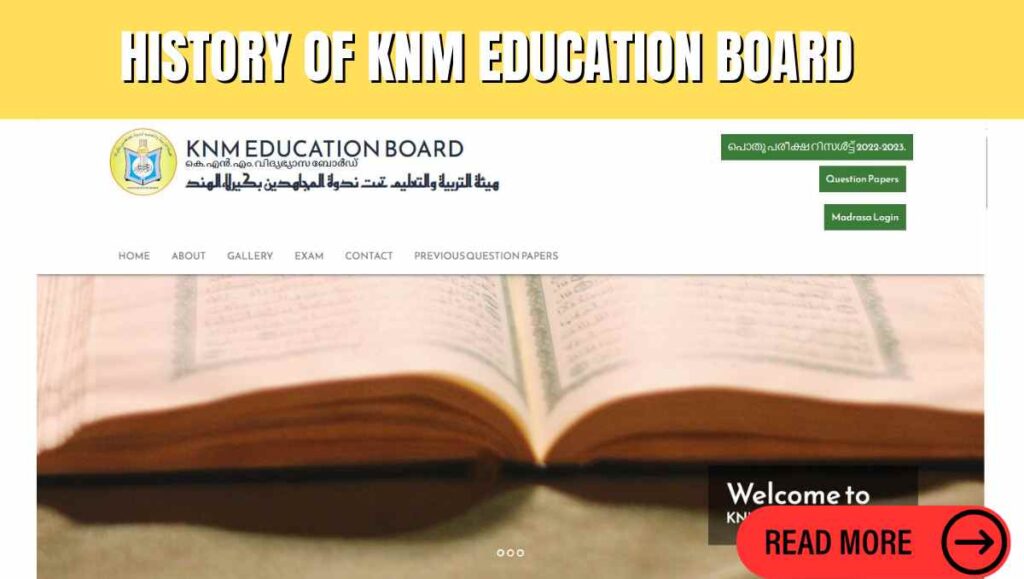In the realm of education, the KNM Education Board stands out with a clear vision and mission. The board’s vision extends beyond traditional boundaries, aiming to revolutionize the educational landscape. Rooted in a commitment to fostering holistic development, its mission is to empower learners with the knowledge and skills essential for a dynamic world. This article delves into the profound aspirations that drive the KNM Education Board.
History of KNM Education Board
After the Kerala Nadwatul Mujahideen (KNM) was formed in 1950, the organization decided to seriously intervene in the field of madrasas. At that time, isolated madrasahs were established in many villages in Kerala. They did not have textbooks prepared on the basis of fixed curricula or scientific evaluation processes. The state council of KNM, which met on October 5, 1955, decided to resolve the deplorable situation in the field of religious education. A ten-member committee was tasked with making a thorough study of the existing problems and ways of solving them and submitting a report.
How KNM Education Board was formed?
NV Abdussalam Maulavi is the chairman of the said committee. M Shaikh Muhammad Moulavi, KP Muhammad Moulavi, EK Moulavi, Muhammad Abussabah Moulavi, Muhammad Amani Moulavi, K K M Jamaluddin Moulavi, PV Muhammad Moulavi, M Abdullahi Moulavi and PP Ubaidu were appointed as members. Who was Maulavi? This committee met several times and studied the issues in detail. The report prepared by them in a short period of time was very comprehensive. That study report contains the curriculum of primary madrasa study for you. Ati A joint meeting was held on March 31, 1956, by the members of the sub-committee, the members of the KNM Advisory Committee, and the representatives of the management of the Madrasahs conducted on Islahi ideals to discuss the matter.
When KNM Education Board was formed
KNM Education Board will be formed. It should have 24 members. On 11-6-1956 they elected Muhammad Amani Maulavi as the Chairman of the Yuga Chair Board. The primary responsibility of the Education Board is to prepare the textbooks according to the prescribed curriculum. For that, 12 textbooks were prepared printed, and distributed that year up to the 1st standard, with Arabic, Aqeed, Akhlaq, Tariq, and Fiqh as the subjects. Books were prepared in Arabic and Malayalam, which led to a great revolution in madrasa education. First year under the board. 26 madrasahs have been approved.
Many Madrasahs without the approval of the textbooks prepared by them will run according to the syllabus and books of the board. The Board prepared programs to conduct in-person training classes to enable teachers to teach as per the new curriculum. Adina Ghathi is a three-month training program. Planned and executed. made by On January 31, 1957, the teacher training class was started at Vaniyambalam. KNM State President KM Maulavi inaugurated it. Then training classes were held in Kozhikode and Edavanna. June 1963. As a guide for teachers. Irshadattuthdrissiyyah is a name. ‘Model Teacher’s Note Arabic Malayalam.’ Published. How should the learner, teachers, assessment, teacher training, etc. be? Described’u-airu. Early years. Madrasa inspections should not be conducted by Chairman Muhammad Amani Maulavi or other members of the Board. K. K. M. Jamaluddin Maulavi was the first to hold the post of muftis.
KNM Education Board: Arabic Language Books
By the 1970s, textbooks were in Arabic and Malayalam. changed to Malayalam script. Arabic Language Books A. Qiraatudawiyyah A Series. Published. Madrasa textbooks from Class A to Class VII have been revised. After 2000, textbooks up to class 10 have become available. Game of the Seventies PT Moiteenku’i Maulvi served as organizational organizer and madrasa muftatish for a time. It was possible to consolidate the madrasahs and bring them into common character. General examination was conducted in A and seven A classes and later in class 10. It is a changed environment in which information technology has evolved to greatly influence public life. Make necessary changes in the system of religious education.
Revolutionizing Education: The Integrative Role of Technology
In the age of rapid technological advancement, the role of technology in education is pivotal. The KNM Education Board embraces this reality, recognizing technology as a powerful catalyst for learning empowerment. From interactive modules to virtual classrooms, this section explores the myriad ways technology is seamlessly integrated into the educational journey, transforming the learning experience for students and educators alike.
Key Features and Benefits of the KNM Education Board
The KNM Education Board boasts a range of distinctive features designed to elevate the educational paradigm. From personalized learning paths to collaborative tools, each facet contributes to an enriching educational experience. This segment unpacks the key features and benefits that set the KNM Education Board apart, illustrating how it creates an environment conducive to optimal learning and growth.
Also Read:
Educators are at the heart of the KNM Education Board’s success. In this section, we delve into inspiring success stories and testimonials from educators who have harnessed the potential of this innovative platform. From transformative teaching methods to enhanced student engagement, these narratives shed light on the tangible impact of the KNM Education Board in real classrooms.
KNM Education Board and Student Learning Outcomes
The ultimate litmus test for any educational initiative lies in its impact on student learning outcomes. This segment explores the empirical evidence behind the KNM Education Board’s influence on student achievement. From improved academic performance to the development of critical skills, we examine how this board translates its vision into measurable results, shaping the future for generations to come.
Homepage |
Click Here |
Official Website |
Click Here |
Join Whatsapp |
Click Here |
